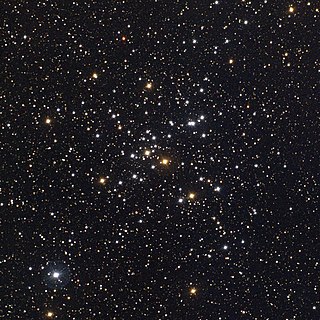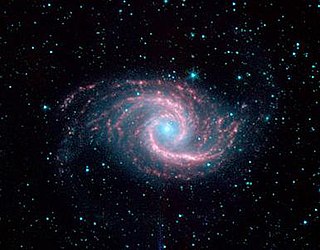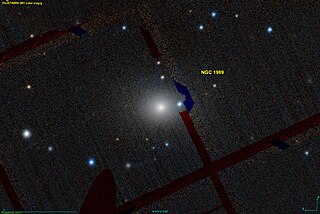
Messier 41 (also known as M41 or NGC 2287) is an open cluster in the constellation Canis Major, sometimes referred to as The Little Beehive Cluster. It was discovered by Giovanni Batista Hodierna before 1654 and was perhaps known to Aristotle about 325 BC. It lies about four degrees almost exactly south of Sirius, with which it forms a roughly equilateral triangle with Nu2 Canis Majoris to the west—all three figure in the same field in binoculars.

Messier 110, or M110, also known as NGC 205, is a dwarf elliptical galaxy that is a satellite of the Andromeda Galaxy in the Local Group.

NGC 1569 is a dwarf irregular galaxy in Camelopardalis. The galaxy is relatively nearby and consequently, the Hubble Space Telescope can easily resolve the stars within the galaxy. The distance to the galaxy was previously believed to be only 2.4 Mpc. However, in 2008 scientists studying images from Hubble calculated the galaxy's distance at nearly 11 million light-years away, about 4 million light-years farther than previous thought, meaning it is a member of the IC 342 group of galaxies.

NGC 1705 is a peculiar lenticular galaxy and a blue compact dwarf galaxy (BCD) in the southern constellation of Pictor, positioned less than a degree to the east of Iota Pictoris, and is undergoing a starburst. With an apparent visual magnitude of 12.6 it requires a telescope to observe. It is estimated to be approximately 17 million light-years from the Earth, and is a member of the Dorado Group.

NGC 1559 is a barred spiral galaxy in the constellation Reticulum. It is also a Seyfert galaxy. Although it was originally thought to be a member of the Dorado Group, subsequent observations have shown that it is in fact not a member of any galaxy group or cluster and does not have any nearby companions. NGC 1559 has massive spiral arms and strong star formation. It contains a small bar which is oriented nearly east-west and spans 40″. Its bar and disc are the source of very strong radio emissions.

NGC 4567 and NGC 4568 are a set of unbarred spiral galaxies about 60 million light-years away in the constellation Virgo. They were both discovered by William Herschel in 1784. They are part of the Virgo Cluster of galaxies.

NGC 278 is an isolated spiral galaxy in the northern circumpolar constellation of Cassiopeia, near the southern constellation boundary with Andromeda. It lies at a distance of approximately 39 megalight-years from the Milky Way, giving it a physical scale of 190 ly (58 pc) per arcsecond. The galaxy was discovered on December 11, 1786 by German-born astronomer William Herschel. J. L. E. Dreyer described it as, "considerably bright, pretty large, round, 2 stars of 10th magnitude near".

NGC 1566, sometimes known as the Spanish Dancer, is an intermediate spiral galaxy in the constellation Dorado, positioned about 3.5° to the south of the star Gamma Doradus. It was discovered on May 28, 1826 by Scottish astronomer James Dunlop. At 10th magnitude, it requires a telescope to view. The distance to this galaxy remains elusive, with measurements ranging from 6 Mpc up to 21 Mpc.

NGC 1672 is a barred spiral galaxy located in the constellation Dorado. It was discovered by the astronomer James Dunlop on November 5, 1826. It was originally unclear whether it was a member of the Dorado Group, with some sources finding it to be a member and other sources rejecting its membership. However, recent tip of the red-giant branch (TRGB) measurements indicate that NGC 1672 is located at the same distance as other members, suggesting it is indeed a member of the Dorado Group.

NGC 5882 is a small planetary nebula in the southern constellation of Lupus, positioned about 1.5° to the southwest of the star Epsilon Lupi. It was discovered by English astronomer John Herschel on July 2, 1834 from the Cape of Good Hope observatory. John L. E. Dreyer described it as "very small, round, quite sharp". It is located at a distance of approximately 7.7 kilolight-years from the Sun.

The Dorado Group is a loose concentration of galaxies containing both spirals and ellipticals. It is generally considered a 'galaxy group' but may approach the size of a 'galaxy cluster'. It lies primarily in the southern constellation Dorado and is one of the richest galaxy groups of the Southern Hemisphere. Gérard de Vaucouleurs was the first to identify it in 1975 as a large complex nebulae II in the Dorado region, designating it as G16.

NGC 5584 is a barred spiral galaxy in the constellation Virgo. It was discovered July 27, 1881 by American astronomer E. E. Barnard. Distance determination using Cepheid variable measurements gives an estimate of 75 million light years, whereas the tip of the red-giant branch approach yields a distance of 73.4 million light years. It is receding with a heliocentric radial velocity of 1,637 km/s. It is a member of the Virgo III Groups, a series of galaxies and galaxy clusters strung out to the east of the Virgo Supercluster of galaxies.

NGC 2082 is an intermediate spiral galaxy in the Dorado constellation. It was originally thought to be part of the Dorado Group of galaxies, but was later removed. It was discovered on November 30, 1834 by John Herschel.

NGC 4698 is a barred spiral galaxy located around 55 million light years away from Earth in the constellation of Virgo. It belongs to the Virgo Cluster of galaxies and is positioned near the northeastern edge of this assemblage. The morphological classification of NGC 4698 in the De Vaucouleurs system is SA(s)ab, which indicates a purely spiral structure with moderate to tightly wound arms. It is inclined to the line of sight from the Earth by an angle of 53° along a position angle of 170°.

NGC 418 is a barred spiral galaxy of type SB(s)c located in the constellation Sculptor. It was discovered on September 28, 1834 by John Herschel. It was described by Dreyer as "faint, pretty large, round, very gradually a little brighter middle, western of 2.", the other being NGC 423.

NGC 1989 is a lenticular galaxy in the Columba constellation. It is about 482 million light-years away from the Milky Way. The galaxy was discovered by John Herschel on January 28, 1835. Its apparent magnitude is 12.9 and its size is 1.40 by 1.1 arc minutes.

NGC 7723 is a barred spiral galaxy located in the constellation Aquarius. It is located at a distance of circa 90 million light years from Earth, which, given its apparent dimensions, means that NGC 7723 is about 95,000 light years across. It was discovered by William Herschel on November 27, 1785. The galaxy is included in the Herschel 400 Catalogue. It lies 1.5 degrees north-northwest from Omega1 Aquarii. It can be seen with a 4-inch telescope under dark skies.

NGC 2525 is a barred spiral galaxy located in the constellation Puppis. It is located at a distance of about 70 million light years from Earth, which, given its apparent dimensions, means that NGC 2525 is about 60,000 light years across. It was discovered by William Herschel on February 23, 1791.

NGC 4299 is a featureless spiral galaxy located about 55 million light-years away in the constellation Virgo. It was discovered by astronomer William Herschel on March 15, 1784 and is a member of the Virgo Cluster.

NGC 6789 is an irregular galaxy in the constellation Draco. It was discovered by Lewis Swift on Aug 30, 1883. It is located within the Local Void, a region of space with far fewer galaxies than its surroundings.




















